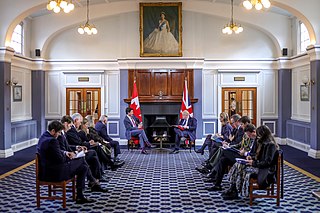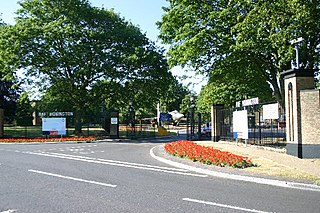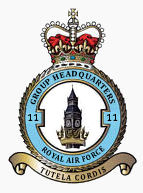
Royal Air Force Kenley, more commonly known as RAF Kenley is a former airfield station of the Royal Flying Corps in the First World War and the RAF in the Second World War. It played a significant role during the Battle of Britain as one of the three RAF stations specifically tasked with the defence of London. It is located near Kenley on the edge of Greater London. The site remains in use with the Ministry of Defence, as Kenley Airfield.

Air Chief Marshal Sir Keith Rodney Park, was a New Zealand-born officer of the Royal Air Force (RAF). During the Second World War, his leadership of the RAF's No. 11 Group was pivotal to the defeat of the Luftwaffe in the Battle of Britain.

Royal Air Force Digby otherwise known as RAF Digby is a Royal Air Force station located near Scopwick and 11.6 mi (18.7 km) south east of Lincoln, in Lincolnshire, England. The station is home to the tri-service Joint Service Signals Organisation, part of the Joint Forces Intelligence Group of Joint Forces Command. Other units include the RAF Aerial Erector School, No. 54 Signals Unit and No. 591 Signals Unit.

Royal Air Force Coningsby or RAF Coningsby, is a Royal Air Force (RAF) station located 13.7 kilometres (8.5 mi) south-west of Horncastle, and 15.8 kilometres (9.8 mi) north-west of Boston, in the East Lindsey district of Lincolnshire, England. It is a Main Operating Base of the RAF and home to three front-line Eurofighter Typhoon FGR4 units, No. 3 Squadron, No. 11 Squadron and No. 12 Squadron. In support of front-line units, No. 29 Squadron is the Typhoon Operational Conversion Unit and No. 41 Squadron is the Typhoon Test and Evaluation Squadron. Coningsby is also the home of the Battle of Britain Memorial Flight (BBMF) which operates a variety of historic RAF aircraft.

Royal Air Force Northolt or more simply RAF Northolt is a Royal Air Force station in South Ruislip, 2 nautical miles from Uxbridge in the London Borough of Hillingdon, western Greater London, England, approximately 6 mi (10 km) north of Heathrow Airport. As London VIP Airport, the station handles many private civil flights in addition to Air Force flights.

RAF Bentley Priory was a non-flying Royal Air Force station near Stanmore in the London Borough of Harrow. It was the headquarters of Fighter Command in the Battle of Britain and throughout the Second World War. The Royal Air Force station closed its operations on 30 May 2008, with all units relocating to new accommodation at RAF Northolt, a few miles away.

Royal Air Force Honington or more simply RAF Honington is a Royal Air Force station located 6 mi (9.7 km) south of Thetford near Ixworth in Suffolk, England. It was used as a bomber station during the Second World War and through the Cold War, hosting Handley Page Victors and Hawker Siddeley (Blackburn) Buccaneers. RAF Honington has been the RAF Regiment depot since 1994.

RAF Uxbridge was a Royal Air Force (RAF) station in Uxbridge, within the London Borough of Hillingdon, occupying a 44.6-hectare (110-acre) site that originally belonged to the Hillingdon House estate. The British Government purchased the estate in 1915, three years before the founding of the RAF. Until the outbreak of the Second World War in 1939, the station was open to the public.

Royal Air Force Wittering or more simply RAF Wittering is a Royal Air Force station within the unitary authority area of Peterborough, Cambridgeshire and the unitary authority area of North Northamptonshire. Although Stamford in Lincolnshire is the nearest town, the runways of RAF Wittering cross the boundary between Cambridgeshire and Northamptonshire.

No. 10 Group RAF was a former operations group of the Royal Air Force which participated in the Second World War.

No. 13 Group RAF was a group in the Royal Air Force for various periods in the 20th century. It is most famous for having the responsibility for defending the North of the United Kingdom during the Battle of Britain.

No. 11 Group is a group in the Royal Air Force first formed in 1918. It had been formed and disbanded for various periods during the 20th century before disbanding in 1996 and reforming again in 2018. Its most famous service was in 1940 in the Battle of Britain during the Second World War, when it defended London and the south-east of the United Kingdom from attacks by the German Luftwaffe. It was reformed in late 2018 as a "multi-domain operations group" to ensure the service thinks and acts in a networked way.

No. 12 Group RAF of the Royal Air Force was a group, a military formation, that existed over two separate periods, namely the end of the First World War when it had a training function and from just prior to the Second World War until the early 1960s when it was tasked with an air defence role.

No. 1 Group of the Royal Air Force is one of the two operations groups in RAF Air Command. Today, the group is referred to as the Air Combat Group, as it controls the RAF's combat fast-jet aircraft and has airfields in the UK, as well as RAF Support Unit Goose Bay at CFB Goose Bay in Canada. The group headquarters is located alongside Headquarters Air Command at RAF High Wycombe, Buckinghamshire. The other operational group is No. 2 Group RAF.

No. 2 Group is a group of the Royal Air Force which was first activated in 1918, served from 1918–20, from 1936 through the Second World War to 1947, from 1948 to 1958, from 1993 to 1996, was reactivated in 2000, and is today part of Air Command.

No. 22 Group Royal Air Force is one of six groups currently active in the Royal Air Force (RAF), falling under the responsibility of Deputy Commander-in-Chief (Personnel) in Air Command. Its previous title up until 2018 was No. 22 (Training) Group. The group is responsible for RAF training policy and controlling the Royal Air Force College and the RAF's training stations. As such, it is the direct successor to Training Group. 22 Group provides training to all three service branches of the British Armed Forces; namely the Royal Air Force, the Royal Navy, and the British Army.

Air Vice Marshal Stanley Flamank Vincent, was a pilot in the Royal Flying Corps (RFC) and later a senior commander in the Royal Air Force (RAF). He was the only RFC/RAF pilot to shoot down enemy aircraft in both world wars.

Air Headquarters Malta was an overseas command of the Royal Air Force (RAF) during the Second World War. It was established on 28 December 1941 by renaming RAF Mediterranean under Air Vice Marshal Hugh Lloyd. Lloyd was named Air Officer Commanding in Malta on 1 June 1941.

The Battle of Britain Bunker is an underground operations room at RAF Uxbridge, formerly used by No. 11 Group Fighter Command during the Second World War. Fighter aircraft operations were controlled from there throughout the War but most notably during the Battle of Britain and on D-Day. Today it is run by Hillingdon Council as a heritage attraction with attached museum. The museum was opened in 1985, with an above ground visitor centre opened in March 2018.
At the end of the Cold War in 1989, the Royal Air Force (RAF) structure was as follows:
























